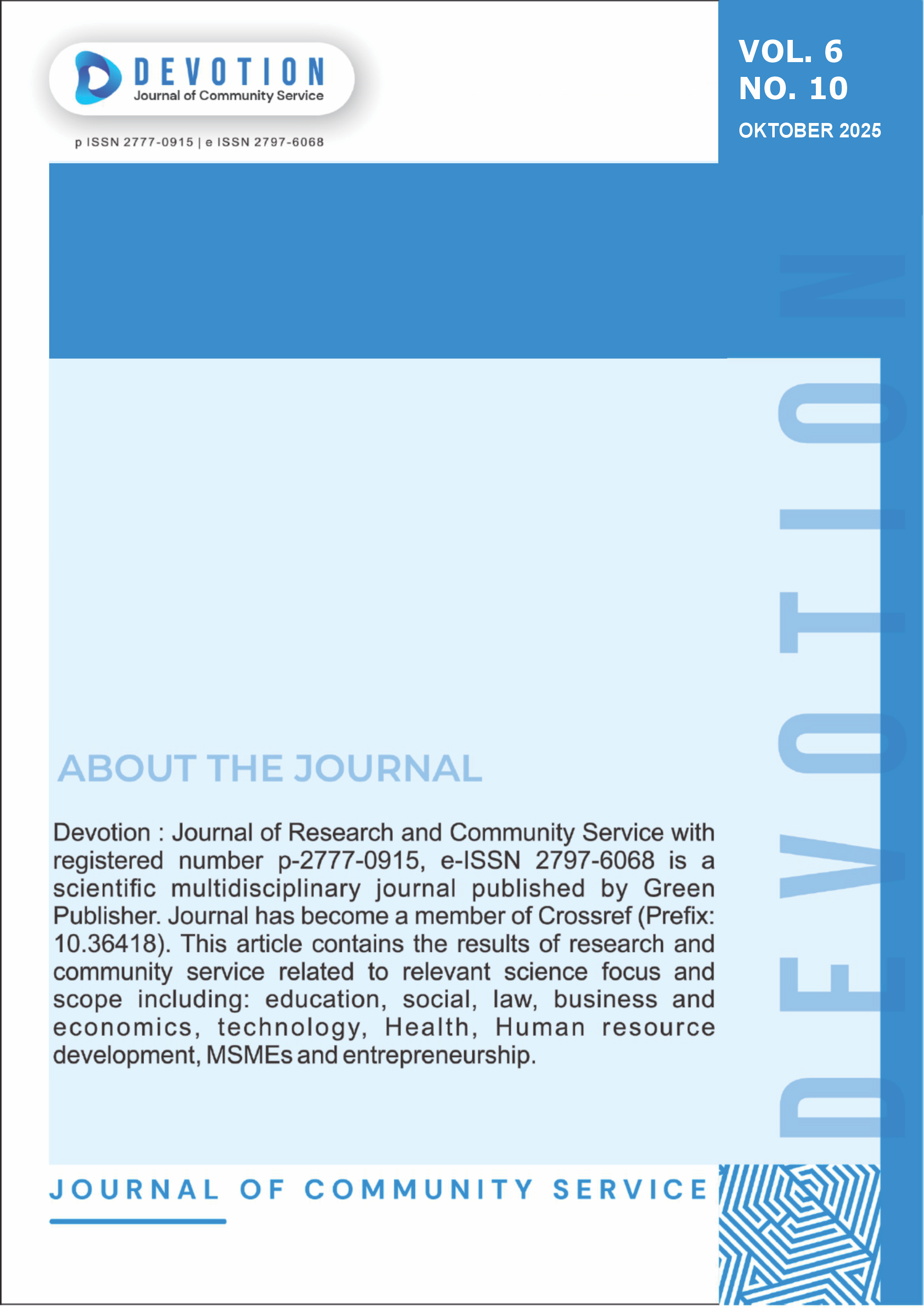A Rare Case of Bladder Calculi (Vesicolithiasis) in a Thirteen-Year-Old: a Case Report
DOI:
https://doi.org/10.59188/devotion.v6i10.25563Keywords:
Bladder stones, Vesicolithiasis; Pediatric urology; Neurogenic bladder; Transurethral cystolithotripsyAbstract
Bladder stones (vesicolithiasis) are a rare condition when diagnosed in children. The incidence is around 2-3% in children. In Indonesia, the incidence is estimated to be higher because several areas are included in the stone belt region, and there are still many cases of endemic stones caused by low-protein, high-carbohydrate diets, and chronic dehydration. In general, the composition of bladder stones consists of infection stones, ammonium urate, and calcium oxalate. Bladder stones are often found accidentally in patients with symptoms of obstruction and irritation during urination. A 13-year-old girl presented with complaints of urinary retention and suprapubic pain at the Malili City Health Center. The patient had a history of paralysis of both lower limbs since the age of 3, following a fall. Over the past year, she had experienced recurrent urinary tract infections (UTIs) and frequent lower urinary tract symptoms. She was referred to Lagaligo Hospital for further evaluation. On physical examination, there were no abnormalities noted except for suprapubic tenderness and the gait is unable to ambulate independently due to longstanding bilateral lower limb paralysis. She requires full assistance for mobility and is wheelchair-bound.Laboratory tests, including renal function and hematological parameters, were within normal limits. Urological ultrasound of the urinary bladder revealed thickened, irregular mucosa and a 2.2 cm stone, consistent with vesicolithiasis accompanied by cystitis. The patient was subsequently referred to Sawerigading Hospital, where she underwent transurethral cystolithotripsy for stone removal. The procedure was performed using an 8 Fr instrument over the course of 1 hour. Stone fragments were successfully evacuated using a suction device, and complete removal was achieved. Bladder stones are rare in pediatric patients, especially in females. In our case, recurrent urinary tract infections (UTIs) were identified as the most probable cause, consistent with the secondary category of vesicolithiasis. The recurrent infections were likely related to the patient’s immobility, being bedridden, and routine use of diapers. In this patient, poor hygiene and incomplete bladder emptying further contributed to the persistence of infections. Ultrasound remains the first-line imaging modality for pediatric urolithiasis due to its non-invasive nature and high diagnostic accuracy. In this case, ultrasound provided clear visualization of both the bladder stone and the associated mucosal changes. Although open cystolithotomy remains the most commonly used method for bladder stone removal in children—reported in up to 99% of pediatric cases (Abarchi et al.)—transurethral cystolithotripsy is increasingly being adopted in selected cases. In female pediatric patients, transurethral cystolithotripsy offers several advantages, including shorter hospital stay, reduced catheterization duration, and lower procedural morbidity. Bladder stones are a rare condition in children. In our case, the most likely underlying cause falls into the secondary category, namely recurrent urinary tract infections (UTIs). Preventive measures include improving hygiene, adopting a high-protein diet, ensuring proper hydration, and providing adequate water sanitation. However, with appropriate management and surgical intervention, good outcomes can be achieved. In this case, transurethral lithotripsy was used as a common technique, and fortunately, the stones were successfully removed in small fragments. No complications were observed in this patient.
Downloads
Published
Issue
Section
License
Copyright (c) 2025 Baso Suriadi, Krisna Sidharta

This work is licensed under a Creative Commons Attribution-ShareAlike 4.0 International License.
Authors who publish with this journal agree to the following terms:
- Authors retain copyright and grant the journal right of first publication with the work simultaneously licensed under a Creative Commons Attribution-ShareAlike 4.0 International. that allows others to share the work with an acknowledgement of the work's authorship and initial publication in this journal.
- Authors are able to enter into separate, additional contractual arrangements for the non-exclusive distribution of the journal's published version of the work (e.g., post it to an institutional repository or publish it in a book), with an acknowledgement of its initial publication in this journal.
- Authors are permitted and encouraged to post their work online (e.g., in institutional repositories or on their website) prior to and during the submission process, as it can lead to productive exchanges, as well as earlier and greater citation of published work.













